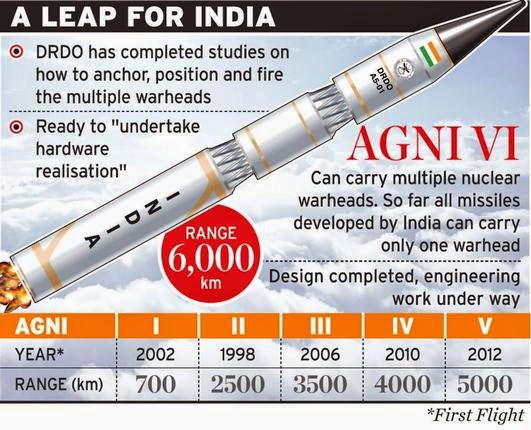The white lines represent the 10,000 km range (with one tonne warhead?) of an Agni 6 (Agni VI) ICBM. The minimum and main Indian objective is the ability for at least one Agni 6 to deploy 3 tonnes of warheads from one missile onto Beijing and also other Chinese east coast centers. The inner red circle is the 4,000 km range (with one tonne warhead?) of Agni 4 (Agni IV) maybe operational in 2017. India's now operational Agni 3 (Agni III) can just reach Beijing with one 500 kg (no MIRV yet) warhead.
---
The flight of the 3 booster-stage Agni 6 with several MIRVs. Note that chaff might also be released to confuse anti-missle dence sensors.
---
The flight of the 3 booster-stage Agni 6 with several MIRVs. Note that chaff might also be released to confuse anti-missle dence sensors.
---
Disregard the "6,000 km". Agni 6 (Agni VI)'s likely specifications are total weight 55,000 kgs, height 17-20 meters, 1.1 - 2.0 metre diameter, 3 stage rocket boosted. Launched from semi-hidden transporter erector launcher (TEL) truck, or disguised rail car.
---
A basic law of physics is that due to gravity and momentum there is an inverse relationship between the weight of a warhead and the range of a missile. For India future ICBMs may have warheads weighing up to 3 tonnes while the lightest warhead is currently 500 kg.
India wishes the 10,000 km range missile, known as the Agni 6 (Agni VI), to have characteristics equal to (parity with) the latest ICBMs of India's main nuclear opponent, China. China's latest ICBM under development is the DF-41 (Dongfeng-41) which will have the range to hit any capital of its nuclear opponents, including London and Washington DC.
For political reasons India probably does not wish to publish a 10,000+ km range that is sufficient to reach the continental US. A 10,000+ km ICBM was to be called the Surya but is rarely mentioned now that India is on closer terms with the US.
The Agni 6 will be an evolutionary development of the Agni series of long range Indian ballistic missiles developed following the test of India's first nuclear device (1974). These warheads are known as Multiple Independently Targetable Re-entry Vehicles (MIRVs)). Carrying multiple warheads (10 is the usual upper limit) on one missile is the most economical way to deploy warheads and such a deployment is more difficult to defeat with anti-missile defences.
Agni 6 may be first tested in 2017 . Testing may last 4 years to 2021. Then in-service, operational around 2023 or later.
If India has developed fusion boosted fission weapons (like Joe-4) the yield of a single warhead missile may be up to 400 kT). If India has developed two-stage thermonuclear weapons - then each MIRV warhead may well have a yield between 100 to 250kt.
Cross reference this article with many concerning the Agni series including:
- The Second Agni 5 Test, Any MIRV? September 16, 2013
- China's, India's and Pakistan's Future Nuclear Rivalry August 12, 2013
- Indian Strategic Weapons Programs - Gradual Progress, July 3, 2013
- Agni 5's First Test in April 2012, April 27, 2012
Pete























